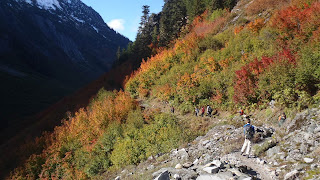The Red-Tailed Hawks met for their second outing of their final year on an absolutely beautiful fall day. The cool, clear weather, the explosion of fall colors, and mostly vacant trails are great reasons to get into the backcountry of the North Cascades this time of year. Before we loaded onto Moose, one of our Wild Whatcom busses, he had a circle and reminded ourselves of the increased risk of exploring deeper in the woods and agreed that we would maintain a backcountry mindset for the remainder of our day together.
 |
| Finding Pikas among the boulders near the trailhead |
When we arrived at the trailhead, we took a moment to gather our packs as the mid-morning sun melted the last remaining patches of snow that fell the night before. Before setting out on the trail, the mentors prompted us to identify where we were. We used our collective knowledge and understanding to place ourselves near the headwaters the Nooksack watershed.
 |
| Lion's Mane fungus |
One of the great aspects of the Hannegan Pass Trail is that it traverses along one side of a valley, alternating between avalanche chutes full of slide alder and vine maple and sections of old growth hemlock and fir forests. On a nice day, like the one that we had, you can see all the way across the valley and see the snow-dusted craggy peaks on the other side. On this hike, the stunning vistas were not located solely at the destination.
The Red-Tailed Hawks were appreciative of the fact that we were granted with so many great views along the way because we never made it to the pass. We have a motto in EC that states, “It’s about the journey, not the destination,” and the RTHs embodied this today. We took many breaks to observe bright yellow and red vine maple leaves, to find some mugwort, and to identify the tall, old conifers in the old growth forests along the way. Of course, we also took time to enjoy our lunches and hot chocolate while appreciating the stunning views across the valley.
 |
| A quick trail break for some food and water |
 |
| Checking out some mugwort |
 |
| Our first glimpse of Ruth Mountain as we come out of the forest |
 |
| Ruth Mountain at the head of the valley |
Back down at the trailhead, we took some time to talk about our EMA program and what being an EMA means. In our EC mentoring community, we often talk about how, “you teach who you are.” We asked the RTHs to think of and share some aspect of themselves that they plan to embody and/or bring to the younger group during their time as an EMA. This exercise did an effective job of highlighting how much experience and wisdom that the RTHs have. The younger groups are lucky to have the RTHs out with them as EMAs.
To finish, we had a circle of thanks where we practiced our attitude of gratitude just like we always do. We also shared excitement as we anticipated our next outing where we will be practicing the Art of Shelter by building snow caves!
To see the rest of the glorious photos from our day together, click here.








































